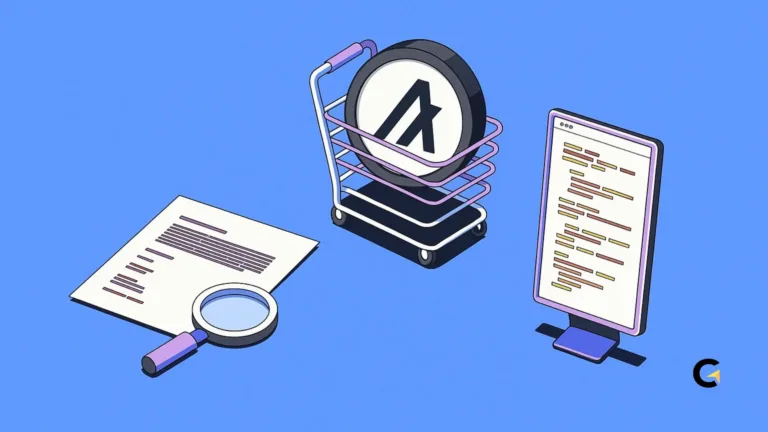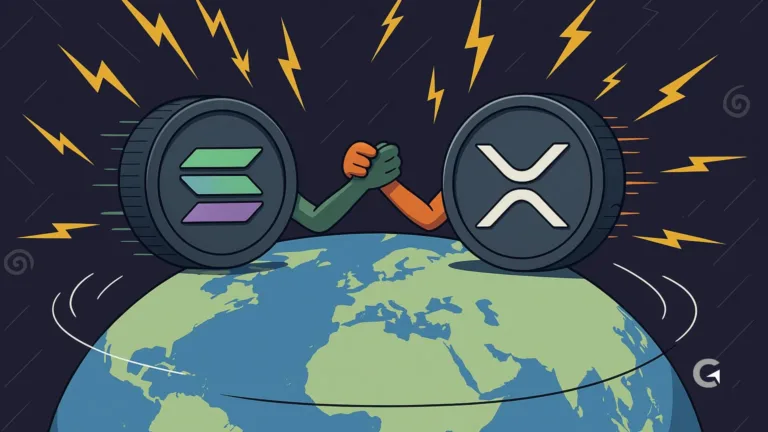POL Price Predictions For 2050
Polygon is undergoing a major transformation through its ambitious Polygon 2.0 initiative, and at the heart of this shift lies the birth of the Polygon Ecosystem Token (POL).
This token isn’t just a rebranded version of MATIC—it represents a bold vision to redefine the structure and function of token utility within the Layer-2 Ethereum ecosystem.
Positioned as the driving force behind Polygon’s next chapter, POL is gradually replacing MATIC over the coming years.
But what exactly is POL? How far can its potential go? And how do we realistically envision its price in 2050 amidst the wild volatility that defines the crypto space?
Principal Conclusions
Hide-
Polygon 2.0 Transformation: POL is replacing MATIC over a four-year period and will serve as the primary token across an interoperable zkEVM ecosystem.
-
Current Market Metrics: POL trades at ~$0.22 with a $2.25B market cap and ~8.92B tokens in circulation.
-
Long-Term Price Drivers: zkEVM adoption, restaking mechanics, token economics, and regulatory dynamics will heavily influence future value.
-
2050 Price Forecasts:
-
Bullish: >$10 (20% CAGR)
-
Conservative: $2.50–$3.50 (12% CAGR)
-
Bearish: <$1–$2 (5% CAGR)
-
-
Uncertainties Ahead: Competitor tech, global regulation, market volatility, and institutional adoption are major variables that could shape POL’s future.
In this article, we’ll take a deep dive into the fundamentals behind POL—from its underlying technology and long-term price drivers to speculative projections based on Compound Annual Growth Rate (CAGR) modeling across three scenarios: bullish, conservative, and bearish. Let’s explore.
The Polygon 2.0 Evolution: POL Is More Than Just a MATIC Replacement
To understand why POL matters, you need to first grasp the scope of Polygon’s reimagined vision.
Polygon 2.0 is a comprehensive overhaul of the network’s Layer-2 framework, now focusing on zkEVM technology and cross-chain interoperability.
POL was designed not only to serve as the native gas token but also as a governance tool, staking asset, and even a restaking mechanism—allowing validators to secure multiple chains across the Polygon Supernet.
Unlike MATIC, which was tied to a single network, POL is built to operate across an expansive multi-chain environment powered by zero-knowledge proofs (zk-proofs).
The zkEVM validium architecture behind it allows Ethereum transactions to be executed off-chain efficiently, without compromising on security.
Think of POL not just as a token, but as the fuel, firewall, and traffic controller of a massive digital metropolis called Polygon.
A Snapshot of POL’s Current Performance
As of June 2025, POL is trading around $0.22 per token—a dramatic drop of over 80% from its all-time high (ATH) of $1.29, reached on March 13, 2024.
With a market capitalization hovering around $2.25 billion and a circulating supply of approximately 8.92 billion tokens, POL currently ranks #42 on CoinMarketCap.
Its daily trading volume remains strong, ranging between $100 million and $120 million, indicating continued market interest despite the recent correction.
However, these figures merely reflect the present. To understand POL’s future, we need to examine the inner workings that will drive its value.
What’s Driving POL’s Long-Term Price Potential?
1. Adoption of zkEVM and Restaking Implementation
zkEVM technology is the catalyst of Polygon 2.0’s resurgence. As more projects adopt zkEVM-based validium solutions to escape Ethereum’s high gas fees, demand for POL as a gas token will naturally surge.
The restaking feature, which lets validators reuse POL to secure multiple chains, also enhances the token’s utility and demand across the network.
This gives POL a clear edge—it’s not just a means of payment; it’s an essential component securing the infrastructure of a multi-chain system.
2. Integration with DeFi, NFTs, and dApps
Polygon has built a strong reputation as a Layer-2 ecosystem that supports DeFi and NFT development. Major protocols like Aave, Uniswap, and OpenSea already operate on Polygon.
With zkEVM eliminating cost barriers, it’s becoming even more attractive for developers to launch scalable and efficient Web3 applications. As this trend continues, demand for POL will likely follow.
3. Competition Among Layer-2s and Polygon’s Competitive Edge
Polygon isn’t alone in the Layer-2 race. Rivals like Arbitrum, Optimism, zkSync, and Base are all competing to offer faster, cheaper, and more scalable solutions.
However, Polygon still holds a strategic advantage in terms of adoption and institutional partnerships. As long as that edge remains intact, Polygon will continue to be a go-to ecosystem for Web3 developers.
That said, should a rival offer vastly superior technology or secure major institutional backing, POL’s dominance could be challenged.
4. Macro Conditions and Global Crypto Regulations
POL’s price is closely linked to broader macroeconomic and regulatory forces. Regulations across the U.S., Europe, and Asia will impact market liquidity and investor sentiment.
Harsh regulatory crackdowns could dampen demand, while institutional adoption may act as a strong upward catalyst.
5. Tokenomics and Supply Emission Mechanics
As of mid-2025, POL has no officially stated maximum supply. Its distribution is clearly allocated for staking, treasury, ecosystem incentives, and development.
Should a deflationary policy (like token burning) be introduced in the future, scarcity could drive long-term value appreciation.
Price Projections for POL Through 2050: Exploring Three Scenarios
Projecting token prices 25 years into the future is speculative by nature. However, using a CAGR-based model, we can establish plausible price ranges under different assumptions. Here are three hypothetical scenarios using annual growth rates of 5%, 12%, and 20%.
| Scenario | Annual CAGR | Projected Price in 2050 |
|---|---|---|
| Bullish | 20% | $14.66 |
| Conservative | 12% | $2.51 |
| Bearish | 5% | $0.75 |
Bullish Case: Mass Adoption and Market Dominance
In the most optimistic scenario, POL becomes the leading token in Ethereum’s Layer-2 landscape.
Restaking sees widespread use, zkEVM gets adopted across sectors, and Polygon becomes the platform of choice for DeFi, NFTs, gaming, and dApps. With a 20% CAGR, POL’s price could hit $14.66 by 2050.
Key drivers:
-
Major partnerships with banks, retail giants, and tech firms
-
Aggressive token burning to reduce supply
-
Strong institutional investment and support
Conservative Case: Steady Growth Without Full Domination
In this scenario, Polygon remains a major player but shares the spotlight with other Layer-2 solutions. A 12% CAGR leads to a 2050 price of $2.51—a more than 10x return from current levels.
Supportive factors:
-
Polygon retains 30–40% Layer-2 market share
-
zkEVM adoption grows steadily amid strong competition
-
Continued but modest strategic partnerships
Bearish Case: Innovation Stalls, Regulation Tightens
The worst-case scenario plays out if rivals like zkSync 2.0, Solana, or Ethereum Layer-1 itself become far more efficient.
Add in global regulatory pressure and declining interest in gas-heavy protocols, and POL could stagnate under a 5% CAGR—ending up around $0.75 in 2050.
Key risks:
-
Major dApps choose faster, cheaper networks
-
Tight regulations in the U.S. and EU limit access
-
Demand for gas declines as Ethereum scales natively
Looking Ahead to 2050: What to Expect?
Technological Innovation
Tech never sleeps. By the 2040s, we might see zkEVM 5.0, or entirely new blockchain paradigms merging AI and decentralized networks. If Polygon continues to innovate and stay ahead of the curve, POL’s relevance—and price—could soar.
Global Crypto Economy
Should POL truly replace MATIC and dominate staking, security, and governance across the Supernet, it may evolve into one of Web3’s essential “backbone tokens.” That would cement its long-term utility and demand.
Institutional Influence and Policy Flexibility
Partnerships with financial institutions can offer credibility and liquidity. However, adaptability in tokenomics—supply caps, burn schedules, reward models—will be essential for balancing scarcity and usability over the decades.
Final Thoughts
The Polygon Ecosystem Token (POL) symbolizes Polygon’s bold move to redefine Layer-2 Ethereum infrastructure. Its foundations in zkEVM, restaking, and cross-chain interoperability offer real utility that goes beyond hype.
Still, like every crypto investment, POL’s future is deeply tied to external forces—technology, competition, regulations, and investor psychology.
Whether POL becomes a $10+ blue-chip token or remains below $1 depends on how well it navigates these moving parts.
For investors, staying informed is key. Understand the fundamentals, follow the tech developments, monitor competitor strategies, and be prepared for a range of outcomes. Crypto never sleeps—and neither does its potential.
Frequently Asked Questions (FAQs)
What is the Polygon Ecosystem Token (POL)?
POL is a new token introduced under the Polygon 2.0 vision to replace MATIC. It’s built to function across the zkEVM-powered Polygon Supernet, serving roles in gas payments, staking, governance, and restaking.
Why is predicting the 2050 price so uncertain?
Because of numerous volatile factors—technological shifts, regulatory changes, macroeconomic conditions, and unpredictable market sentiment. Long-term forecasts always carry significant uncertainty.
What are the key factors that could drive POL’s price?
- Full zkEVM implementation
-
Widespread adoption of restaking
-
Institutional partnerships and capital influx
-
Tokenomics reforms like burning or supply caps
Does POL have a maximum supply?
As of June 2025, no official maximum supply has been announced. However, token allocation strategies are in place for staking, ecosystem incentives, and development.
How can I track POL’s price in real time?
Platforms like CoinMarketCap, CoinGecko, Binance, Coinbase, and Crypto.com offer real-time POL data, including price charts, volume, and market cap.







